Monday was Remembrance Day here in Canada. Last year on Remembrance Day we lost Jack Tremblay who, as a fifteen-year-old, created two war strips for Bell Features; one about a fictional air ace called “Crash Carson,” and the other about air warfare in the European theatre called “Wings over the Atlantic.” Jack made it through boot camp and basic training but was just young enough to miss seeing any action when the war ended before he could be deployed. He still felt that he had made a solid contribution to the Canadian war effort by being part of Canadian war time comics and bringing the fight against the Axis to kids across the country.
Thankfully, active battle, and the rubble of life it produced, never properly made it across the oceans to Canadian shores. Still, the war was everywhere in Canada for six years, from the late summer of 1939 to the corresponding late summer of 1945. Our own Canadian comics were a direct product of that war and we wouldn’t have had them without it. They were our wartime comics not because they had soldiers in them, but because they were a direct product of the war.
For the duration of the war, their job was to connect Canadian kids with the reality of the war overseas and the necessity of the home front effort outside their front doors, and, not least, with other kids across the expanse of a sparsely populated second largest country in the world. We can clearly see those nobler aims through the lens of an eight-decade hindsight. When publishers took the risk of filling the void left by the absence of American comics on our newsstands, they simply wanted to become viable and that meant convincing Canadian kids to buy these comics by entertaining and engaging them. This they were able to do while the war was on and the American books were held at bay.
In this column, I want to look at our wartime Canadian comics not as the slabbed decimal commodities or the collector’s trophies that comics have become in the last couple of decades, but as the disposable documents and remaindered or forgotten artifacts of a key period in Canadian history and identity. I’d like to examine how these comics worked at engaging Canadian kids during this difficult time of the country’s military service overseas.
In Canada’s first comic book, Better Comics Vol. 1 No. 1 (March 1941), the only real reference to the war is in a two-and-a-half-page text story entitled “Sid Pearson.” In it, the title character manages to capture a Nazi U-Boat that had come up-river in an unnamed location. It was two-and-a-half pages of textual connection to the war tucked into the middle of a 52-page comic that was 90% panelled entertainment that didn’t mention the war at all. The first inkling of the war appears on the back cover of Better Comics Vol. 1 No. 2 with a set of colour army related cut-outs.
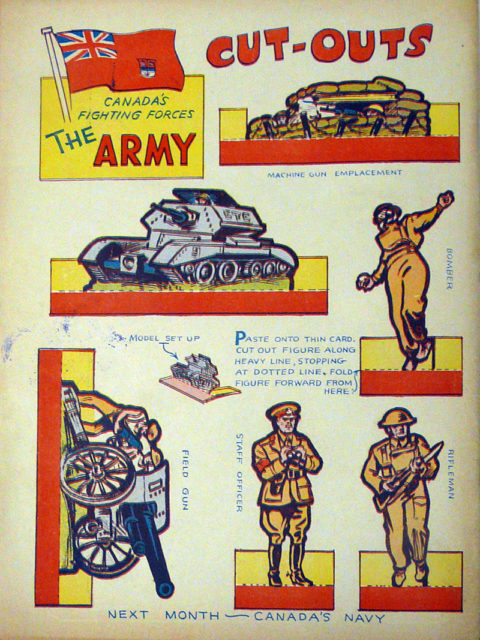
However, a month later, the war literally explodes into Canadian comics with the cover Better Comics Vol. 1 No. 3 (May 1941). This cover depicts the Earth Torpedo busting through a Nazi U-Boat under the waters of the Atlantic off the shores of eastern Canada.
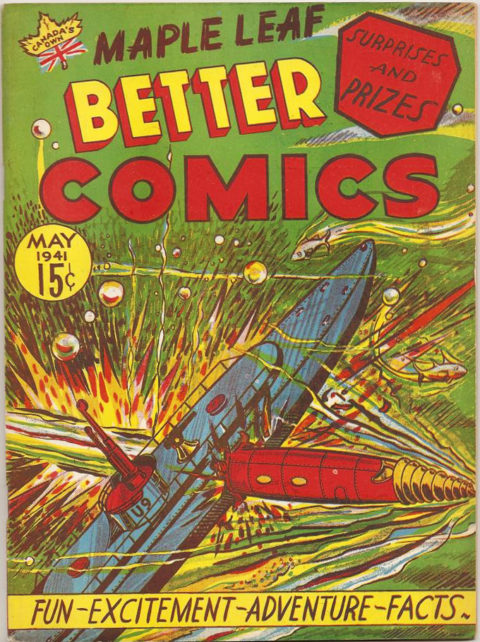
The only other Canadian comic title around at the time (those four Anglo-American Fox reprints may have been around as well) was Anglo-American’s Robin Hood Comics which was simply reprinting old Toronto Evening Telegram dailies in comic book form.
Not only does Vernon Miller smash the Earth Torpedo through a U-Boat on the front of that third issue of Better Comics, but he pits The Iron Man against an enemy agent plane that attacks his friend, the Major’s, boat. Ernie Walker also does a historical biography story about Canadian Lord Beaverbrook that concludes with Beaverbrook’s ongoing efforts to defeat the Axis. With this issue, the patriotic and military context of our first Canadian comics is set for the next four-and-a-half years. In fact, our first comics struggled to find a footing for a year-and-a-half after the war ended and American comics flooded back onto the stands.
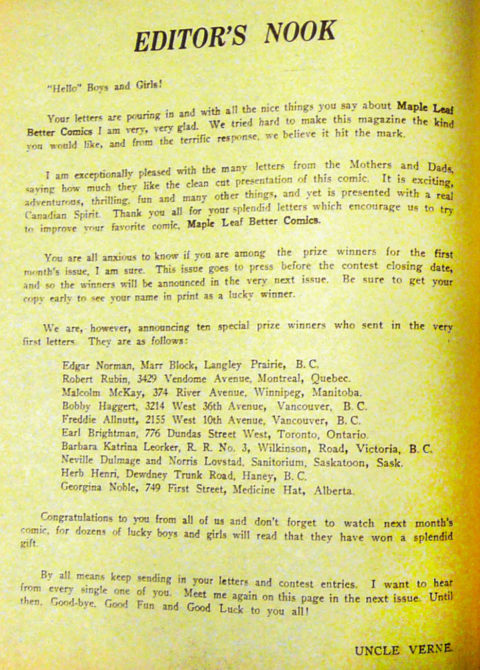
Though the war properly entered Canadian comics through the third issue of Better Comics, the names of Canadian kids who were readers of these new Canadian comics first appeared in the second issue of the title. There Vernon Miller reprinted the names of ten of the earliest readers to send in letters to Better Comics, and this was the start of what was to become another central theme in Canadian wartime comics: the conscious effort to directly engage a young wartime audience (both male and female) with their comics beyond being simply entertained by them.
They did this by encouraging readers to write in with their ideas and opinions about the content of the comics, as well as by having readers participate in contests with the hope of winning prizes and seeing their names, and sometimes their artwork, published in one of the issues. This was months before Freelance and Nelvana and any of the Bell heroes or Canada Jack hit the stands. I believe that it was this impetus, as it evolved, that gave our first Canadian comics an overall character that distinguished them from what was going on in the four-colour universe below the border.
In May of 1941, Better Comics Vol. 1 No. 3 published the names of 50 contest winners from all over Canada and it turned out that 30% of them were female, even though there were no specific stories targeting females in those first couple of issues of Better Comics. For any of you who were around during the early years of comic fandom in the 1960s and attended any of the cons in the first three decades of fandom, how many female fans, or even females who admitted to reading and liking comics, did you come across?
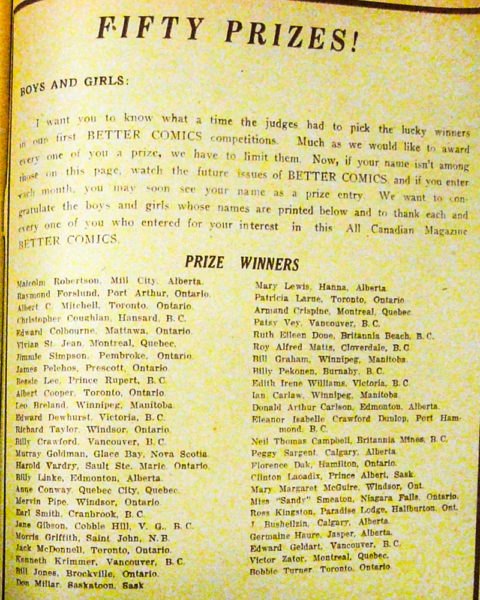
Here’s Vernon Miller’s editorial comment from that same issue:
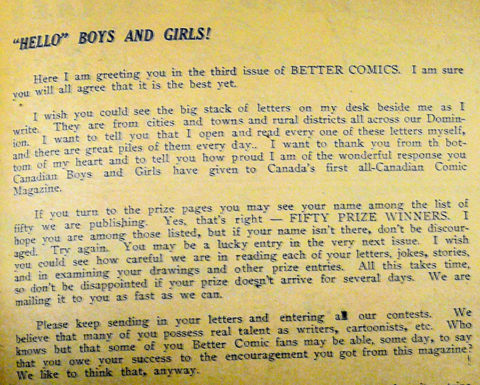
Vernon Miller extended this engagement of his readers even more in that third issue of Better Comics by devoting an exclusive page to them. The figurehead and master of ceremonies for this page was himself a kid, a high school boy named Denny (whether real or fictional), and the title of the page was “Denny’s Cross-Country Talent Review.”
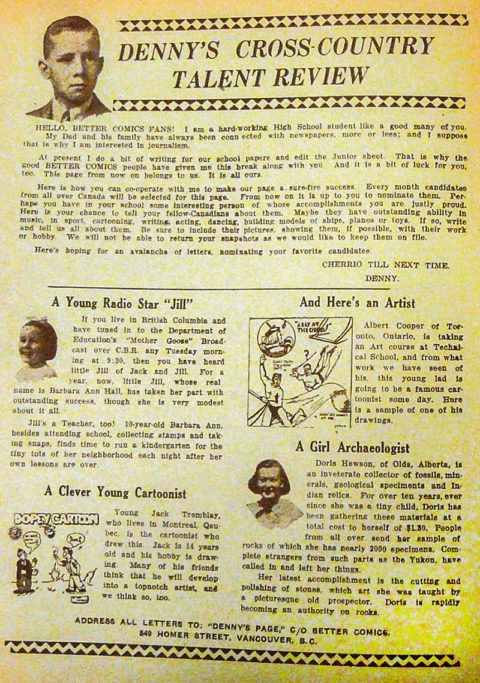
Of the first four kids featured on the bottom half of this page, two are girls from western Canada (B.C. and Alberta) and two are boys, one from Montreal and one from Toronto. The irony is that the two boys, Jack Tremblay and Al Cooper, actually became professional artists and storytellers for Cy Bell and Bell Features comics in less than a year.
In Better Comics Vol. 1 No. 4, Denny’s page features a refugee girl’s own account of her escape from Norway when the Nazi’s invaded.
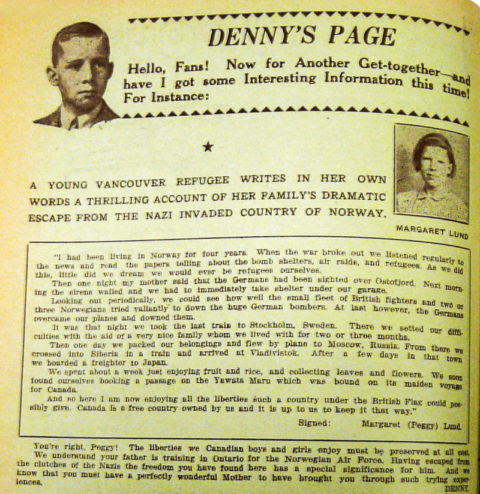
The contest winners page is also notable for the inclusion of Aram Alexanian from Hamilton, Ontario on the third line. He would have just turned 14 and would end up working as an artist for Bell Features himself in a couple of years, not to mention the fact that he would be running a major Canadian carpeting and flooring company in less than twenty years.
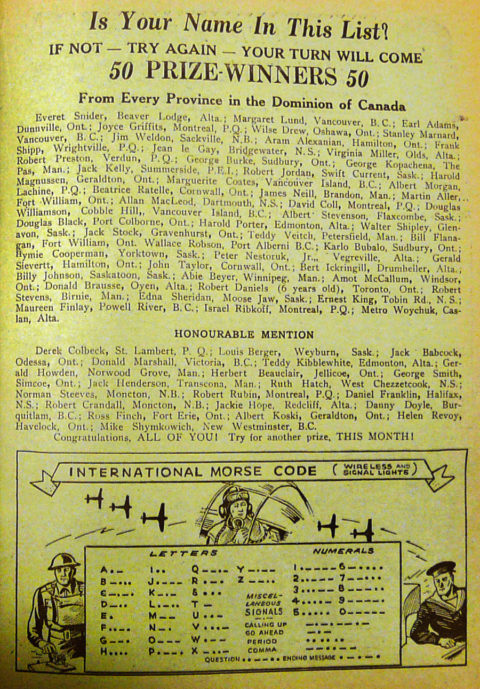
The fifth issue of Better Comics has Denny talking about the end of the school year and summer vacation and making the point that kids shouldn’t forget about the war effort and buying war stamps just because school was over. The contest winners list in this issue prints the readers’ ages for the first time and you can see that the demographic ranges from 8 year-olds to 15 year-olds who were from across all of Canada. (I must note that in all the Canadian war time comics I’ve looked at, I’ve never come across a letter from a reader from Newfoundland which didn’t become part of Canada until 1949. This may mean that the wartime comics were never distributed there and that Newfoundland was still getting American issues.)
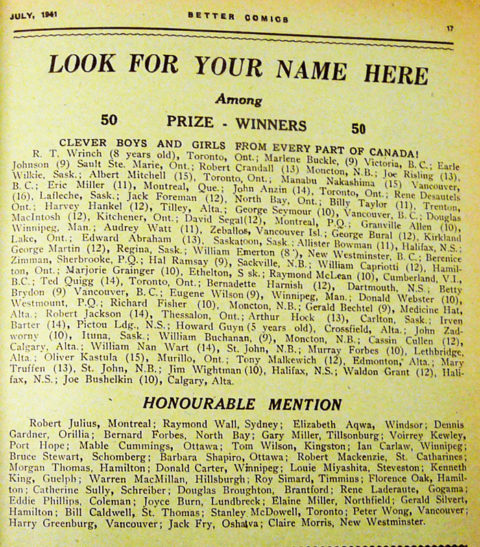
I must also bring attention to the fact that the winners’ list in this issue offers up the name of a 15-year-old Japanese resident of Vancouver named Manabu Nakashima in the third line and the irony here is that in less than a year, he and his family would have probably been in an internment camp.
I’m not sure yet how many issues of Better Comics Denny’s column ran. It skips issue 6 probably because of summer vacation and comes back in issue 7 with a salute to the Duke of Kent, who was visiting Canada at the time. It also appears in issue 10 where Denny urges Canadian kids to guard against the Axis and fifth columnists here at home and to keep buying war stamps. That page also has a small info piece on and a picture of Maple Leaf artist Bert Bushell.
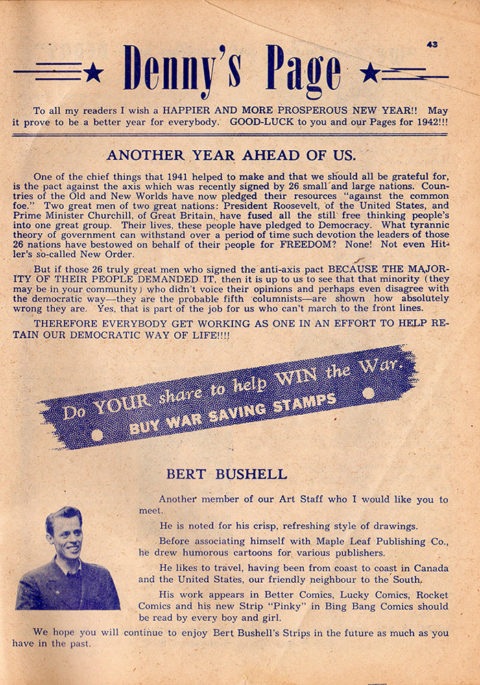
The last copy of Better Comics that I have access to, which has a Denny’s Page, is Vol. 2 No. 1 dated Apr.-May 1942. This is a two-page spread that features over a dozen photographs and a couple of drawings sent in by readers.
This push for reader engagement and listing of readers’ names existed in all the Maple Leaf titles for the first two years or so of the company. Here are some examples:
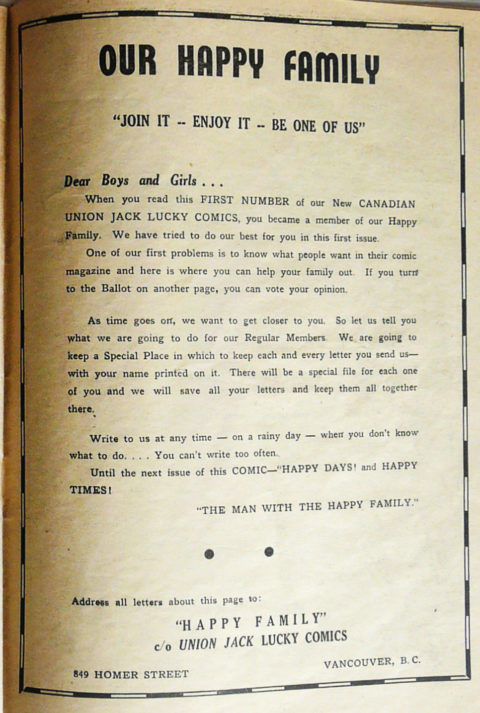
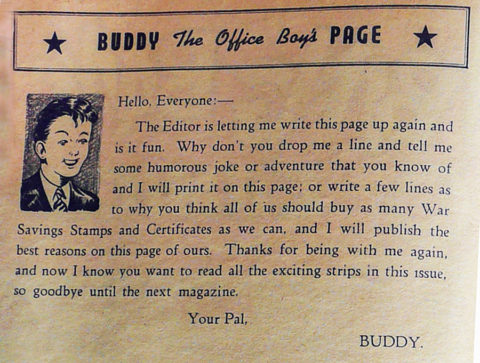
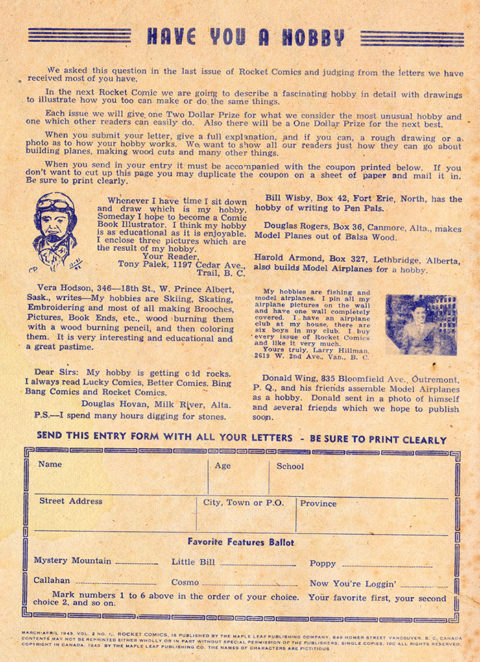
But after that (from the end of 1942 onward), most Maple Leaf titles drifted away from direct reader engagement and became comics that were sold to strictly entertain. Luckily, by the time Maple Leaf had dropped the ball concerning reader engagement in the comics, Bell Features and the Active Club had come onto the scene.
Commercial Signs/Bell Features had readers’ contests right and reader engagement right from the beginning with the “Why I like Wow” comics on the inside back cover of its first book, Wow Comics No. 1 (Sept. 1941) and printed the names of the 25 winners in the third issue.
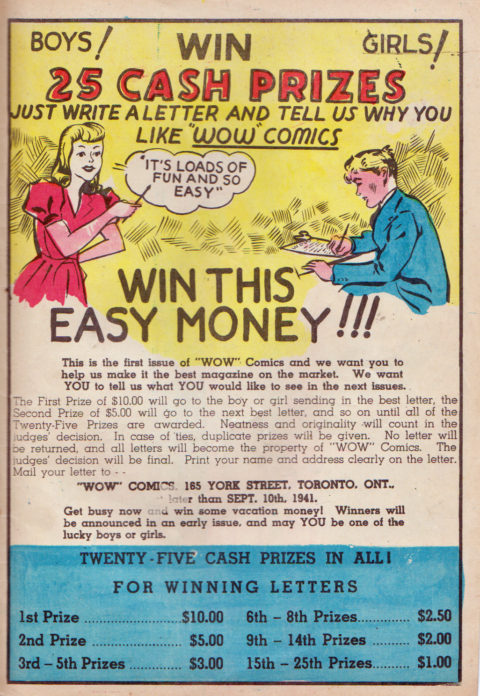
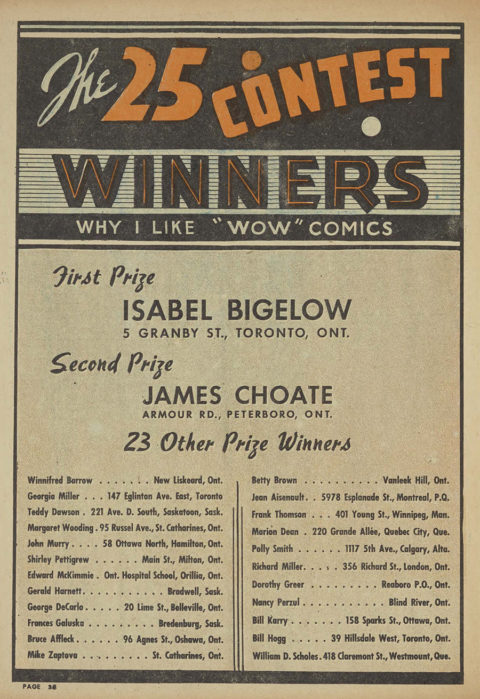
The contest in the second issue of Wow Comics asked readers to fill out a six-panelled page where only the first panel was given to them for a pair of roller skates and the announced winner in Wow Comics No. 5 was 15-year-old Jack Tremblay who, three issues later was working for Bell Features and had his character, Crash Carson, as the cover feature for that issue.
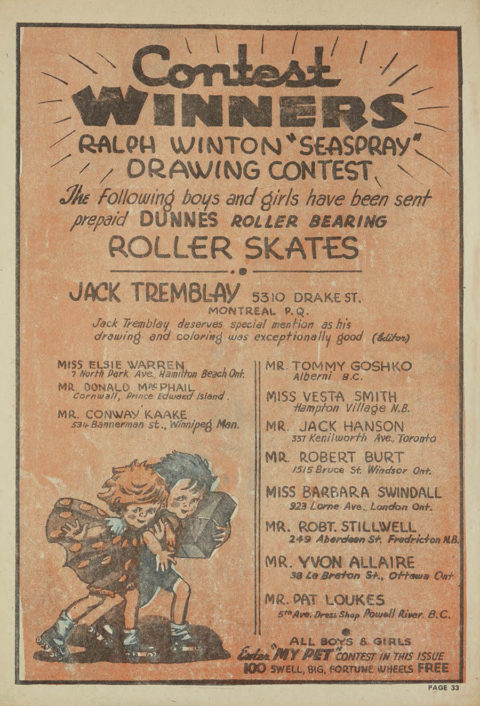
However, Bell Features upped its concern with reader engagement while it was still called Commercial Signs of Canada. This occurred on the inside front cover of Active Comics No. 3 (April 1942?) with the first “Active Club News and Views” page. Active Comics No. 3 also contained the first Active Jim story (which looks to be drawn by Mel Crawford) featuring the figurehead of the Active club and the first Active Jim Message page. Here are all three from Active Comics No. 3:
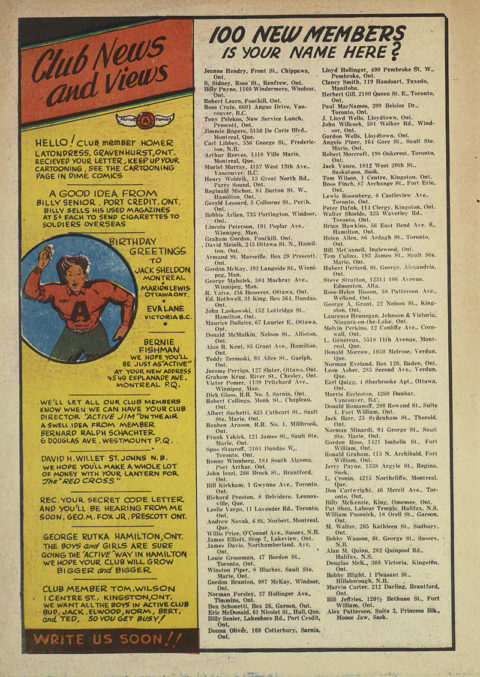
There is some confusion here because I can’t find any solicitation for the Active Club in either of the previous two issues, so it looks like Cy Bell just decided to gather up all the names of the contest entries and letters from readers that had been sent into Active Comics and form a club around a newly created character called Active Jim.
Still, this Bell Features three-pronged assault on reader engagement started in Active Comics No. 3. Active Jim also begins to appear as a secondary character on the covers of the title with issue No. 4 and continues to do so right up to issue No. 8. The Active Jim Message and Active Club News and Views themselves continue right up to and include Active Comics No. 22. Active Jim Message pages then disappear from Active Comics seemingly because the war in Europe ends at this point. However, Active Jim stories, drawn by Ross Saakel, Edmond Good, and Fred Kelly continue right up to Active Comics No. 27, the second-to-last issue. The only blip is in issue No. 20 (the one with the hockey cover) where the Active Jim story seems to be replaced by a Tedd Steele story about Cy Bell’s new Toronto midget hockey team, The Panthers. After Active Comics No. 22, Active Club News and Views pops up only one more time in the title and that is in issue No. 25 to showcase some of its British readers.
The best way to explain what these Active Club pages were about is to reproduce some of them here:
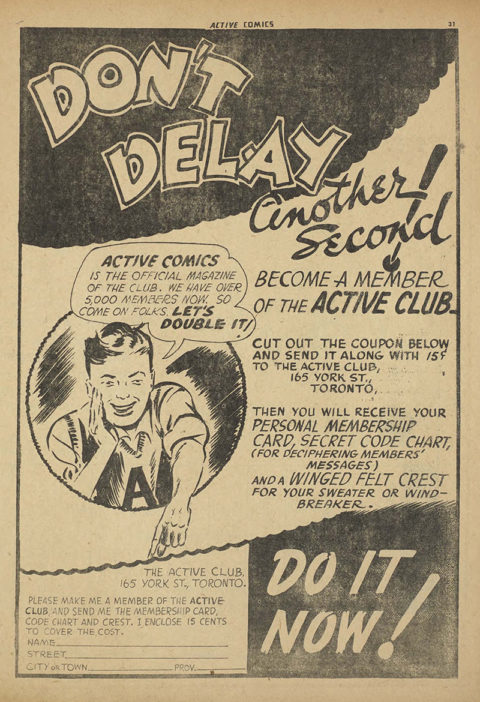
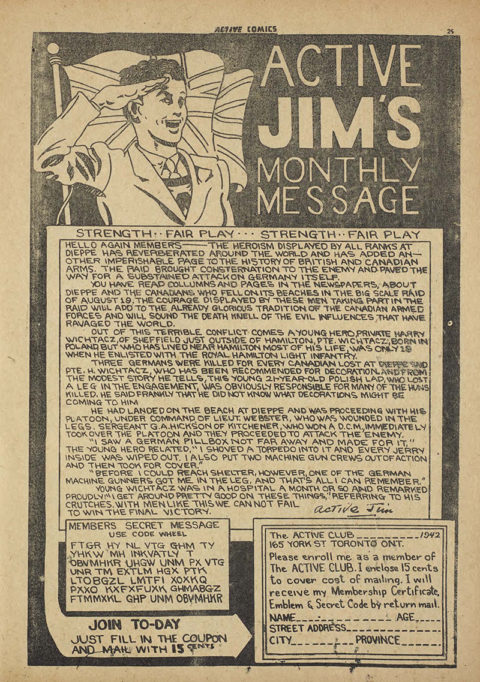
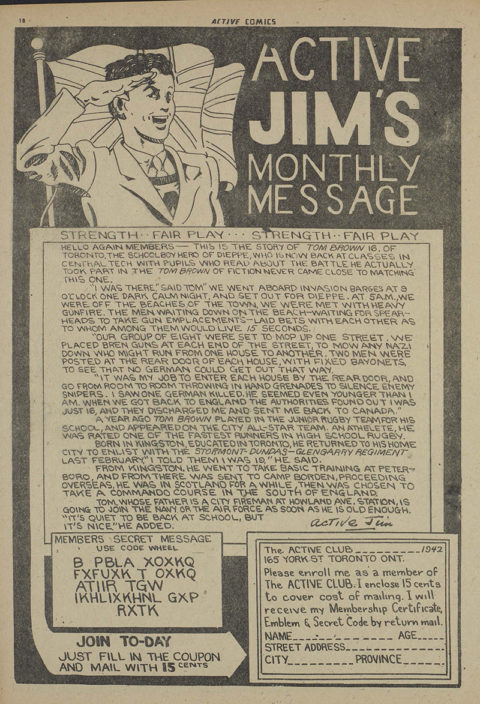
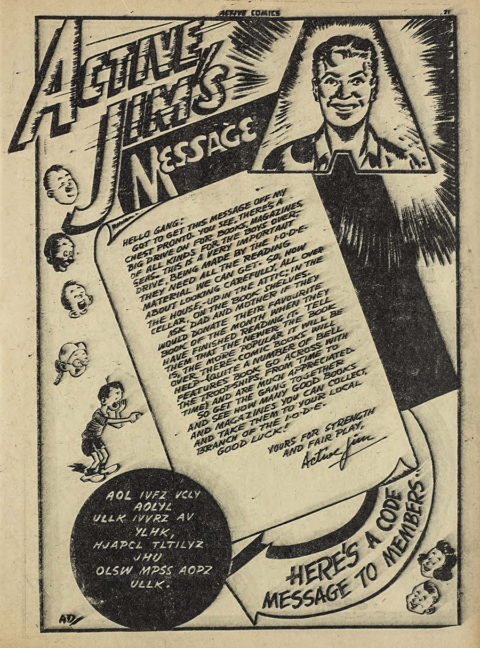
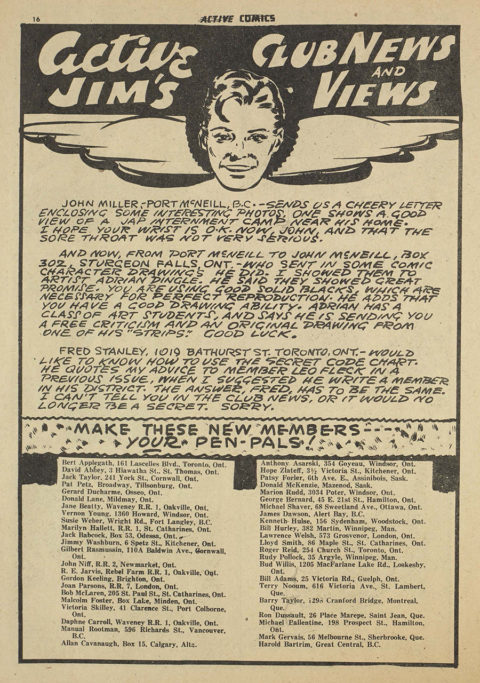
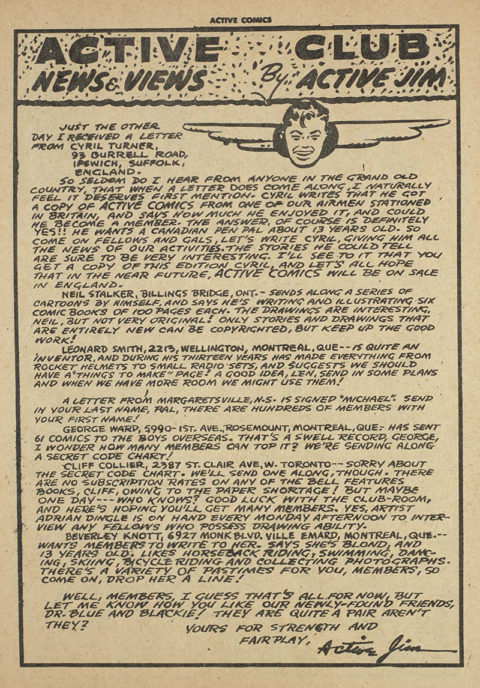
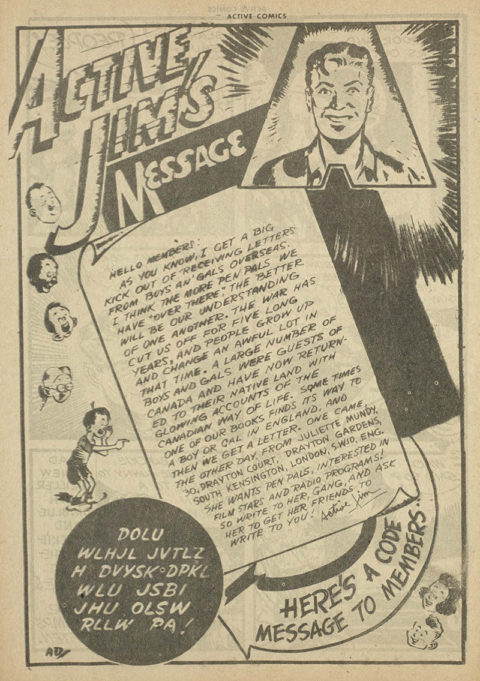
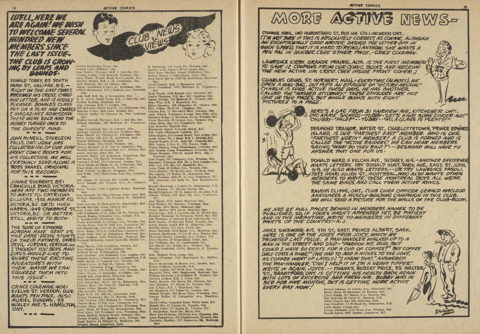
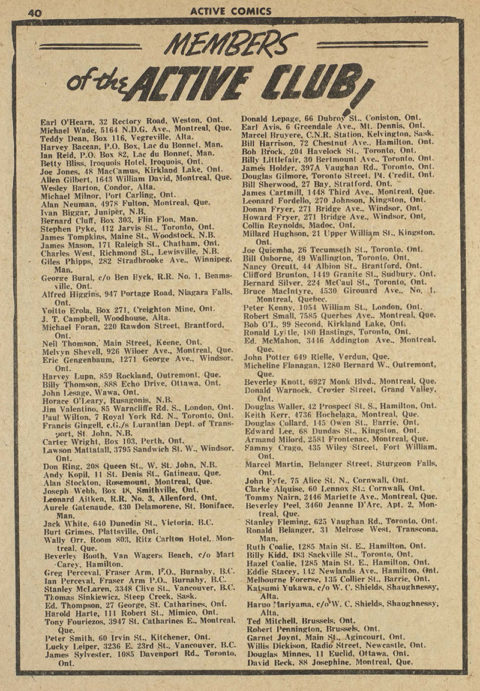
I’ve found one more instance of the Active Club News and Views printed on the back cover of Dime Comics No. 30 (the one with the octopus cover) which maybe implies that Cy Bell wanted to continue the club through the reprint era.
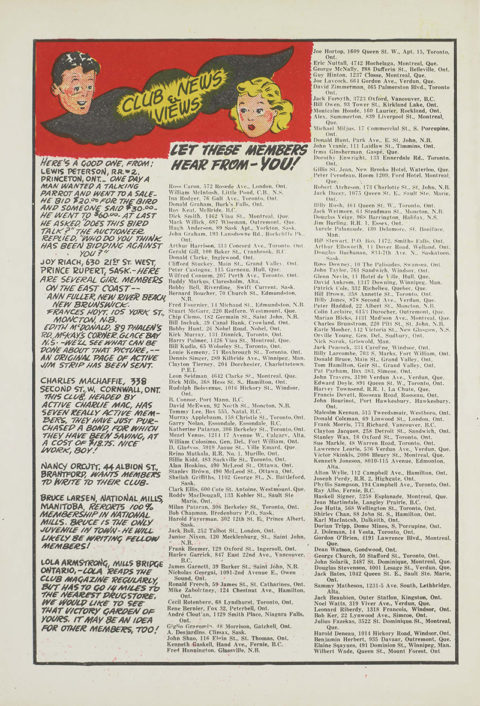
In summary, you can see that the Active Club was an early kind of wartime social networking for kids across the country and even stretched, on occasion, across the Atlantic. These pages also provided Canadian kids of the time with stories from the front lines and how they can best serve the war effort at home.
The last of the big 4 Canadian comic book publishers onto the scene was Educational Projects with its first issue of Canadian Heroes cover-dated October 1942. Canadian Heroes was a different kind of comic that was modelled after American factual titles like True Comics or Real Heroes. It covered actual Canadian events and people from the war, from sports, and from history. Publisher and editor Harry Halperin explains the mandate he envisions for the title on the inside back cover of that first issue:
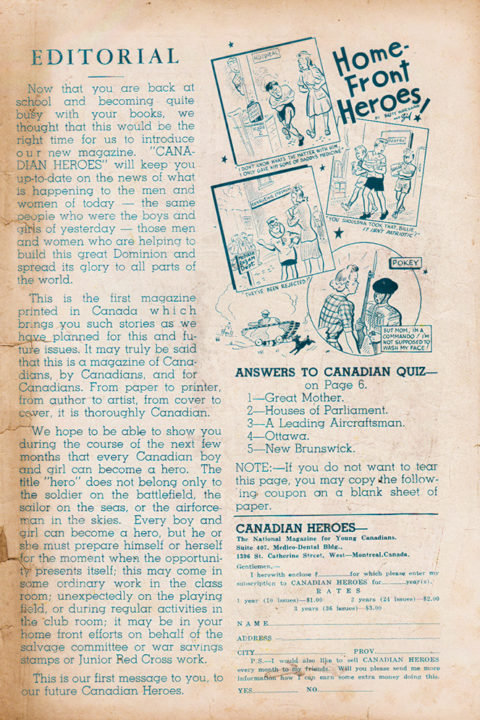
One way Canadian Heroes connected our kids to the war was by soliciting and reproducing letters to them directly from government officials. Here is the one from Minister of War Services Joseph Thorson on the inside cover of the very first issue as well as one from Minister of Agriculture James G. Gardiner from Canadian Heroes Vol. 4 No. 3 (August 1944):
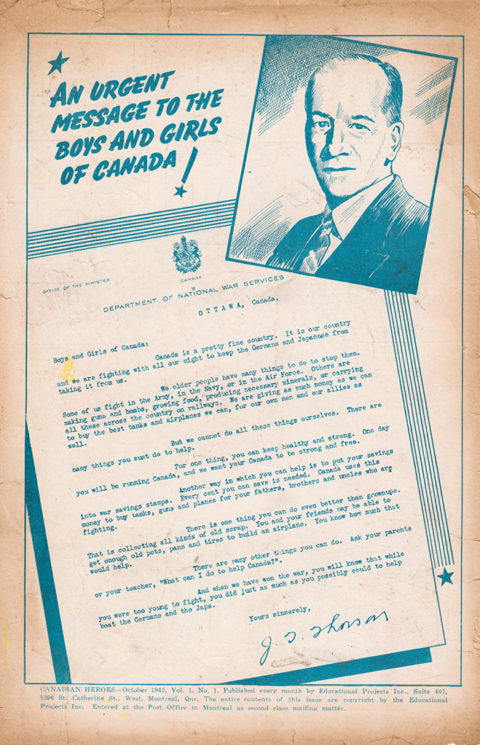
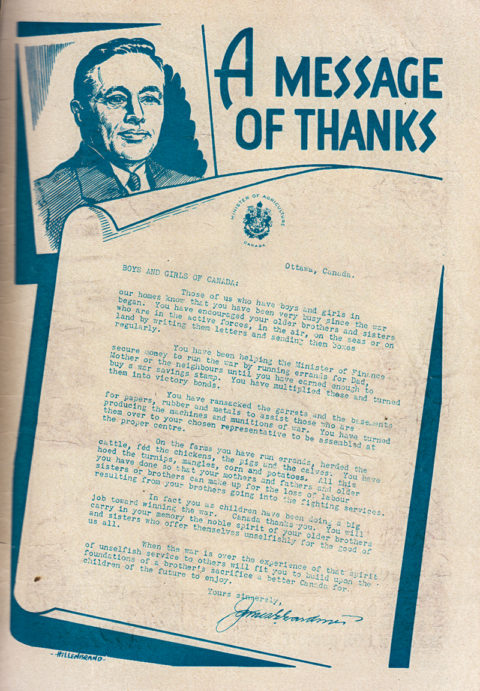
The title also made an effort to cover war events as soon as they happened. In reviewing Canadian Heroes’ first year run on the inside back cover of its twelfth issue (Vol. 2 No. 6), Harry Halperin, directly mentions some of the “scoops” that Canadian Heroes was able to share with its readers:
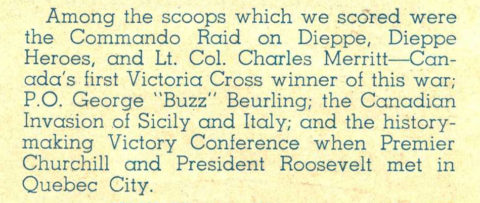
One proper example of this was the Canadian Heroes’ coverage of the D-Day invasion. Canada acknowledged the 75th anniversary of D-Day on June 6 this past summer. Canadian Heroes Vol. 4 No. 3 with the cover of August 1944 (we know that comics actually hit the stands about a month or more before their cover dates) was able to provide our kids with two Sid Barron features about that D-Day invasion. These kids may have heard snippets about it on the radio or even seen a newsreel or two about it at the cinema, but they probably wouldn’t have read newspaper coverage at all. Here was the news of the time directed right at them in a medium they understood and appreciated.
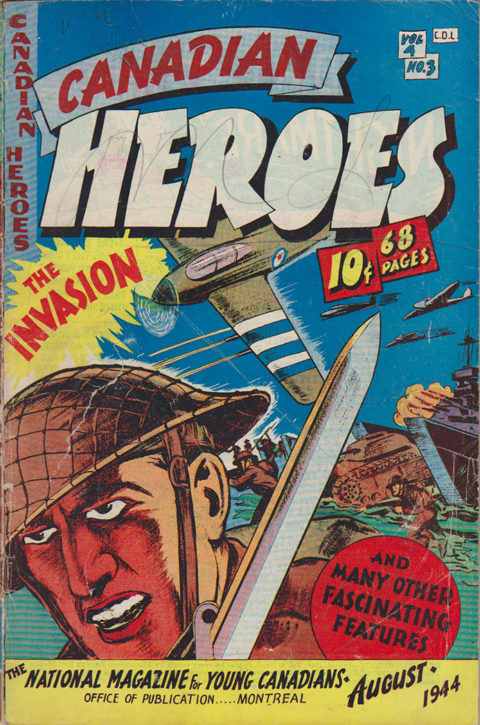
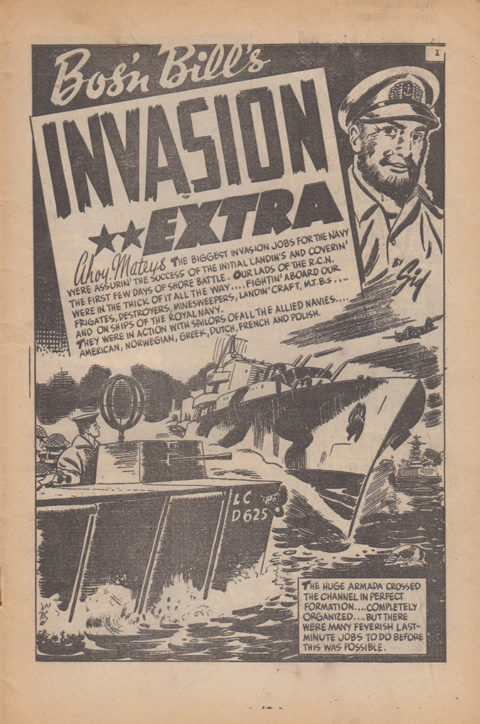
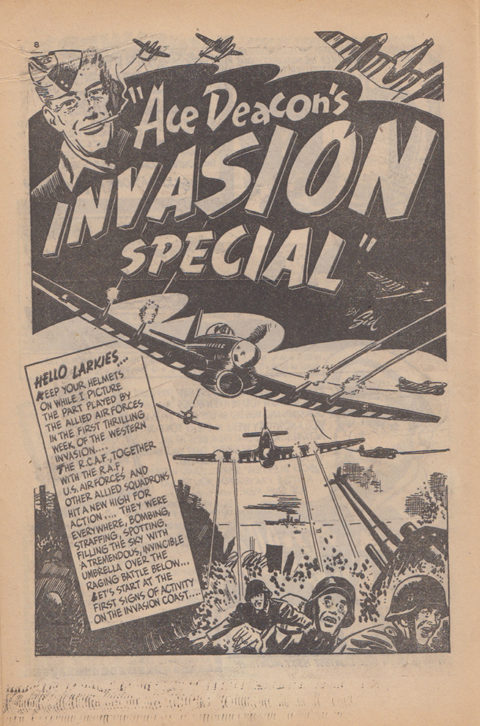
In its fifth issue, Canadian Heroes introduced a fictional character named Canada Jack. He was a strong, fit, and agile Canadian in a sort of gymnastics outfit who battled against the fifth column at home. In fact, Canada Jack was the only Canadian golden age hero to sport any kind of maple leaf on his outfit. Remember that our flag at the time was the Union Jack and we didn’t get our maple leaf flag until 1965. Canada Jack’s aim was to demonstrate to Canadian kids that they should do their duty at home by remaining vigilant against any signs of Axis activities or infiltration.
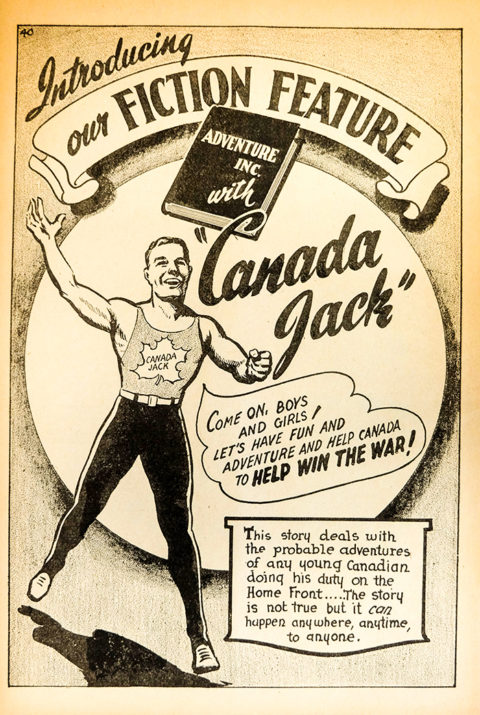
More significant for our purposes was the solicitation for a Canada Jack Club which appeared four issues later in Canadian Heroes Vol. 2 No. 3 (July 1943):
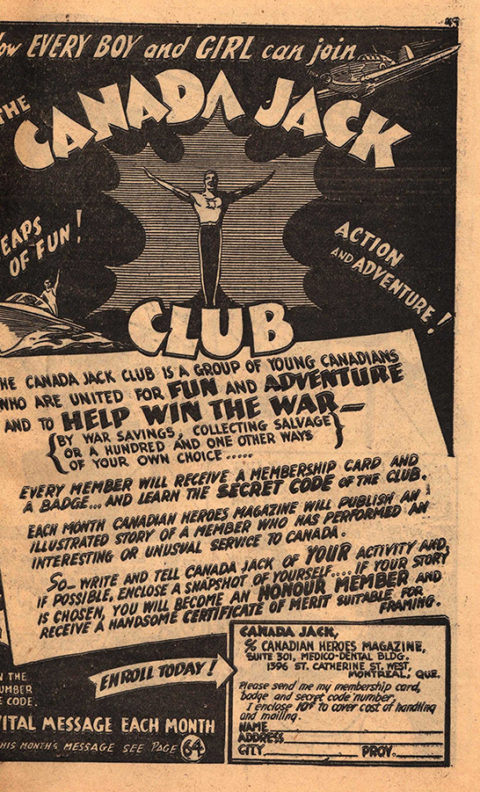
The Canada Jack Club page appears for the first time in Canadian Heroes Vol. 2 No. 6 (October 1943) featuring four boys who create and sell their own comics while in hospital:
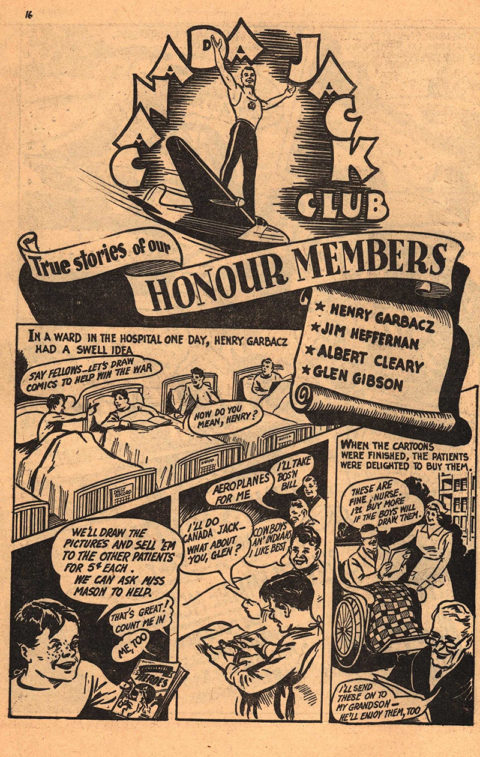
These pages were all drawn by George Menendez Rae, the same artist who drew the Canada Jack and RCMP features in the title. The Canada Jack Club pages evolved into featuring drawings of members done by Rae from photos sent in by the kids or their parents. Again, this provided primitive cross-country social networking for Canadian kids during wartime. Here are some examples:
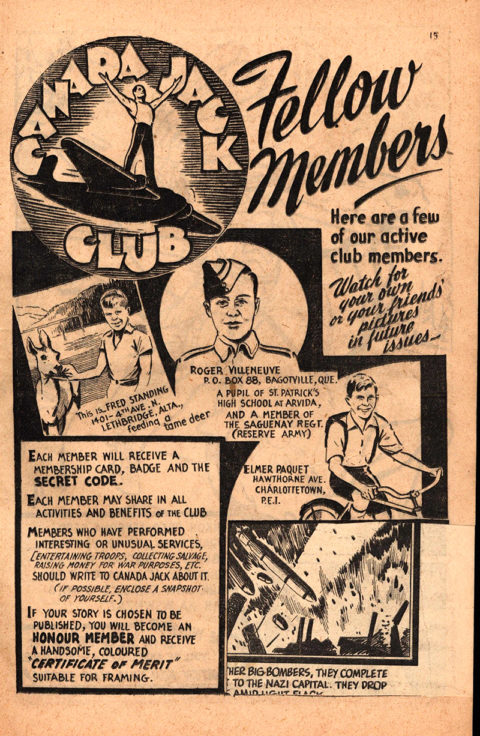
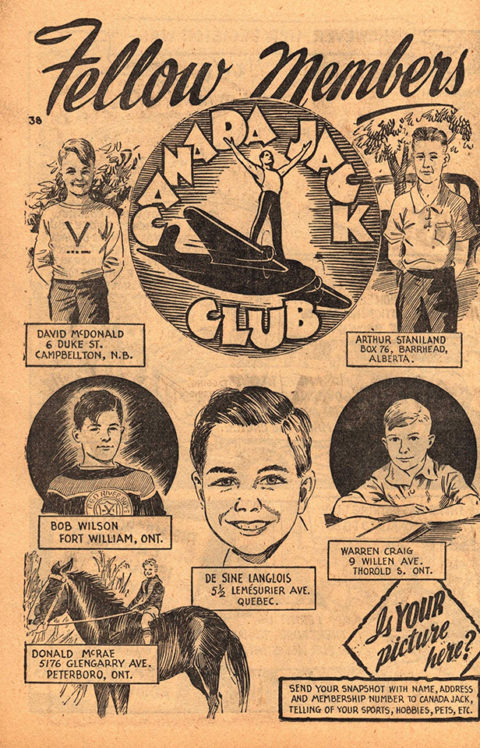
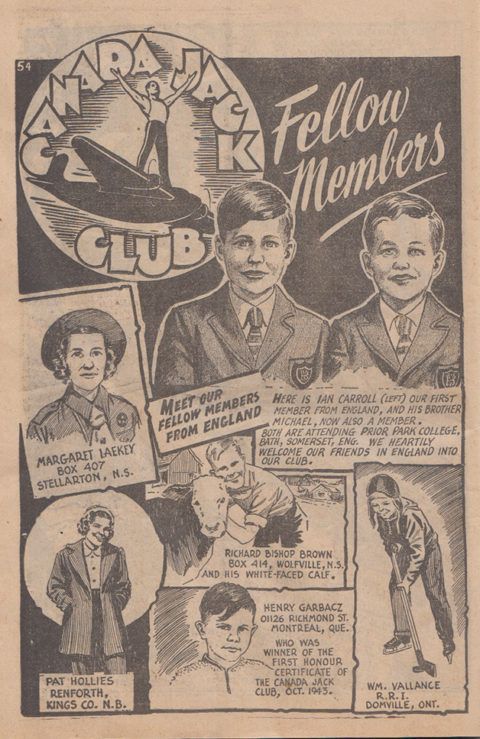
The thirtieth and last issue of the title, Vol. 5 No. 6 (October 1945) simply reproduces the photos of members, perhaps a signal that Rae was unable to do the illustrations because the publisher was going under:
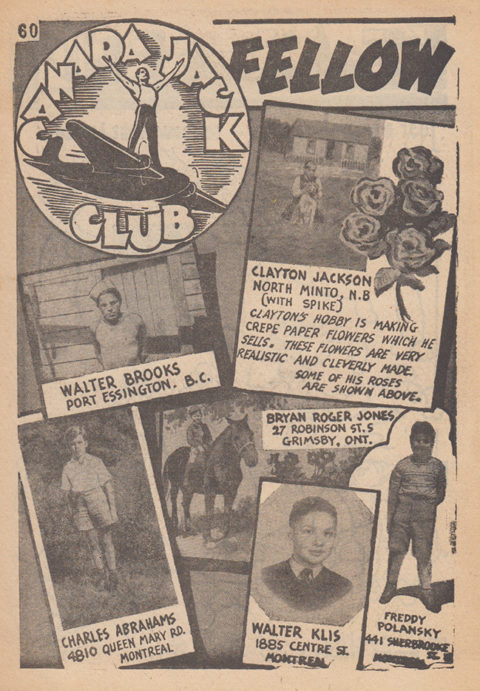
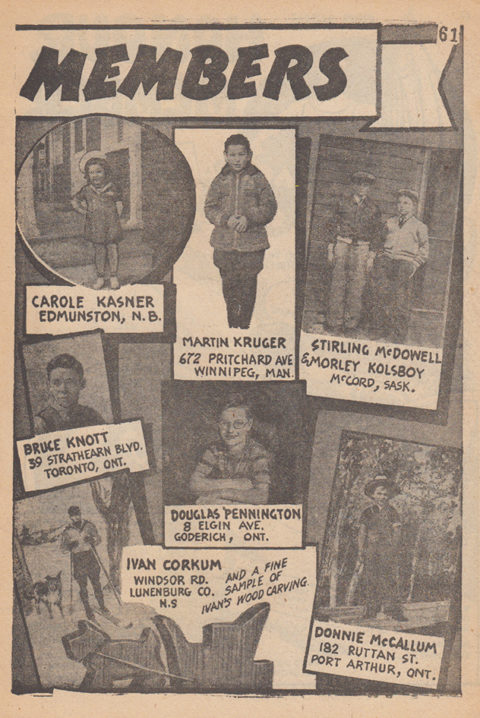
The Canada Jack Club pages also often featured an “Honour Club Member,” that is a member who had made a special contribution to the war effort and could serve as an example to other members and Canadian kids in general. Here are some examples of Canada Jack Club Honour Members:
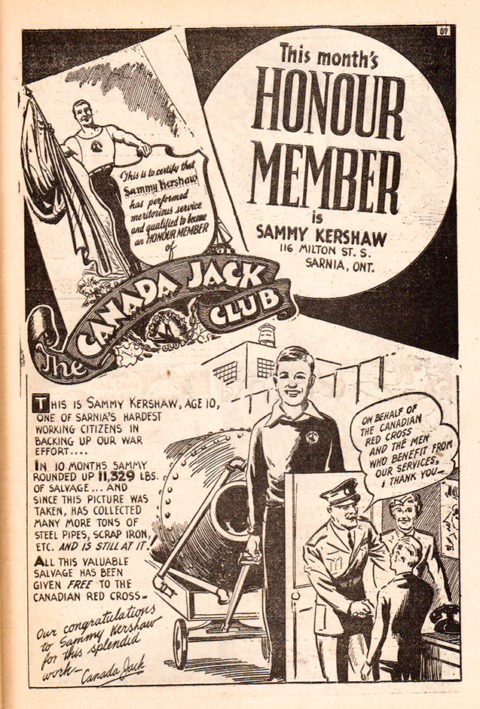
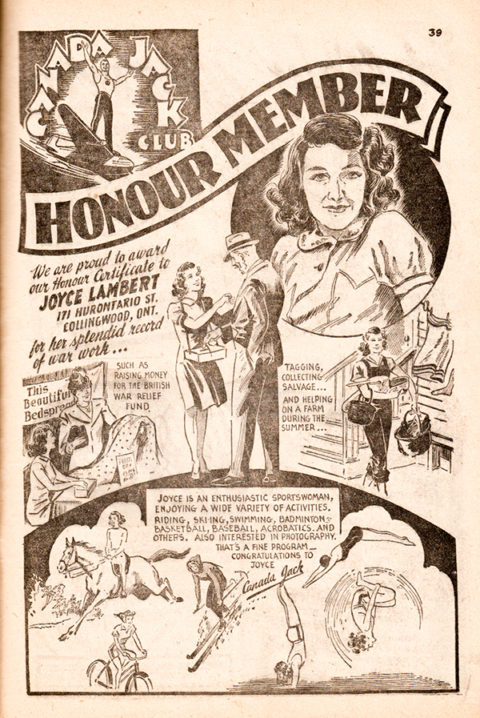
In summation, there is a strong current of engaging the young readers throughout the run of our Canadian war time comics. Publishers did this by:
- providing Canadian kids with their own Canadian comic books created by Canadians and featuring Canadian characters involved in the struggle against the Axis
- offering up information about Canada’s involvement in the war in a medium more engaging to them than newspapers, newsreels, or radio reports
- soliciting input and feedback on the stories that were running in the comics and on the focus and direction that the comic books should take
- having contests for their young readers so that they could win prizes and see their names or artwork in print as winners
- creating pages and clubs that provided for a type of early social networking during the war allowing kids to write to each other and to learn about and share how they could support the war effort at home.
These Canadian war time comics have generally been lost and forgotten for present-day Canadians but they did play an important role for kids during the war, one whose shoes American comics could never have filled and Canada would have been much the poorer without them.
NEWS
Global News National has a small clip that has Gerry Lazare, myself, and Hope Nicholson in it talking about Canadian war time comics: https://globalnews.ca/video/6137634/canadas-golden-age-of-comics-during-wwii

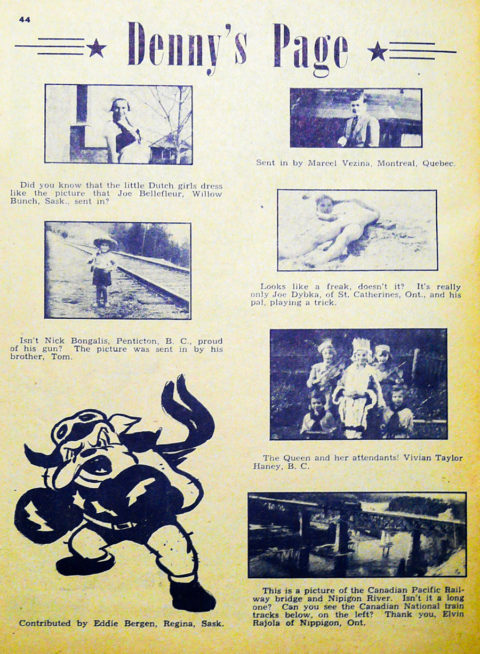
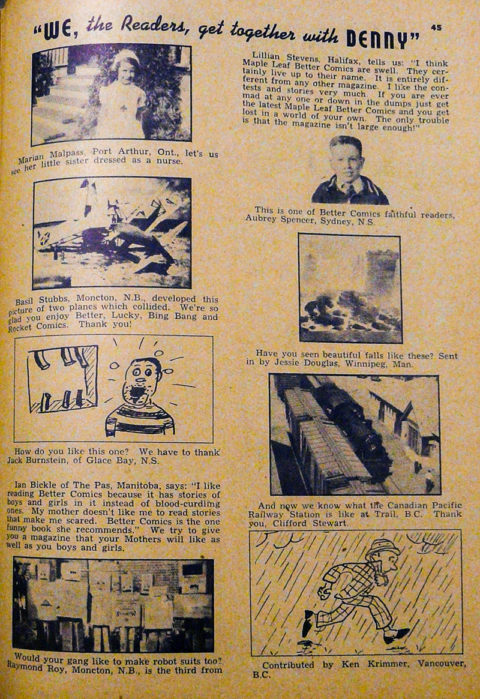
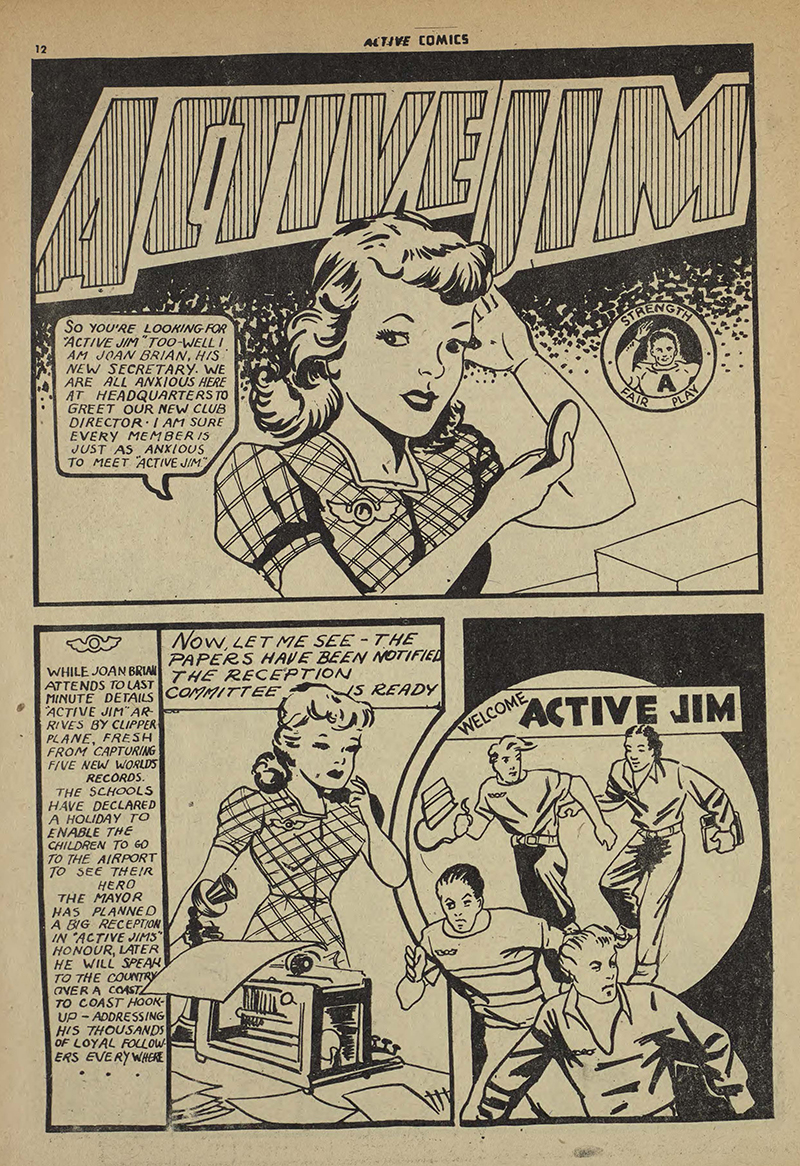
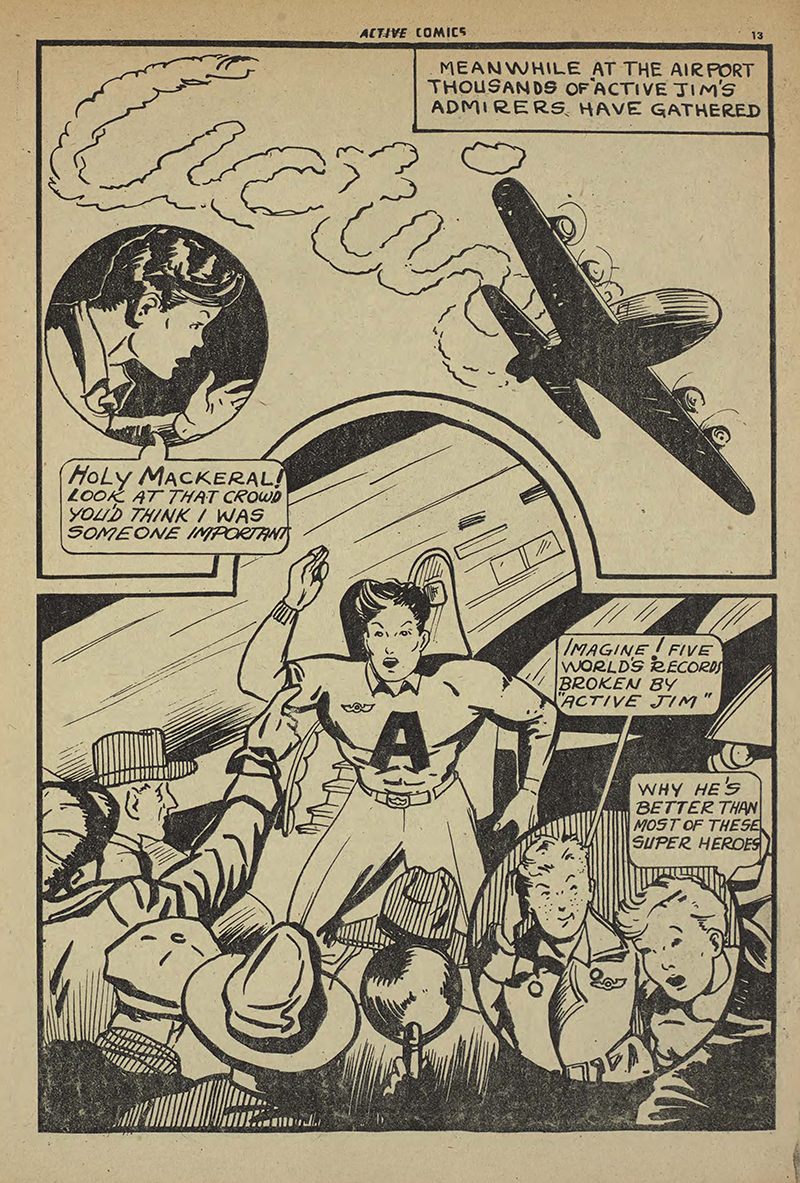
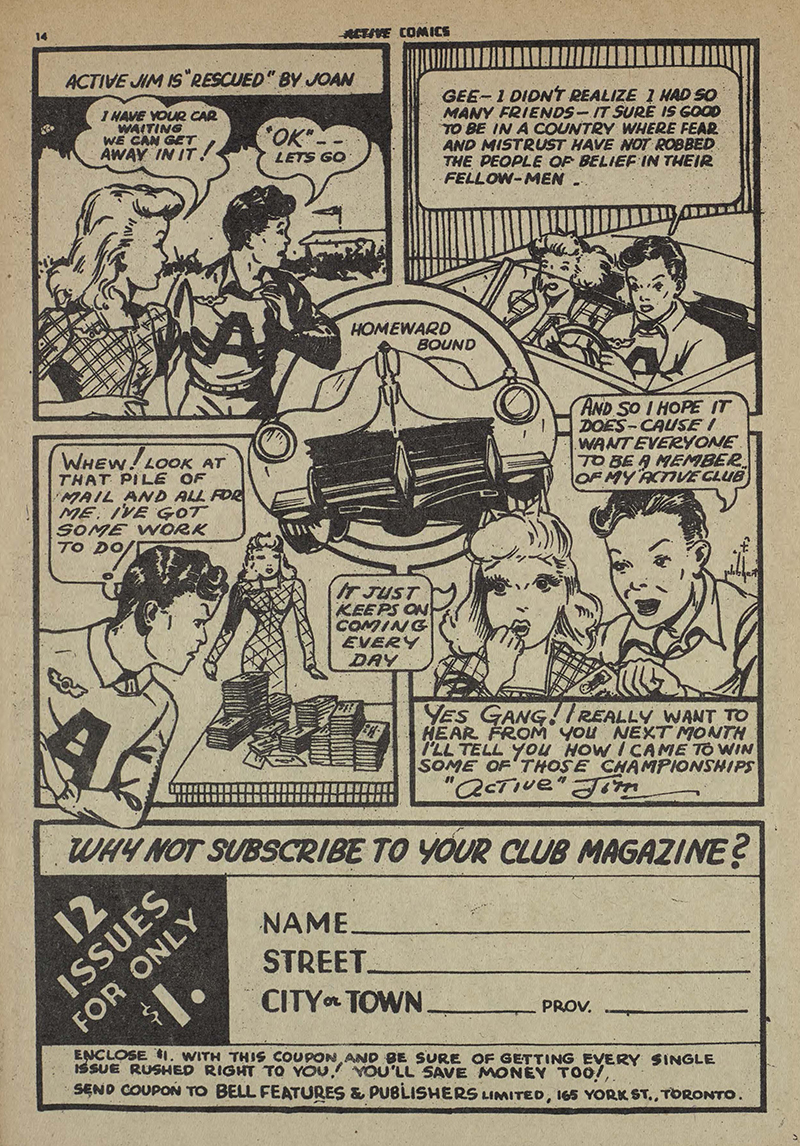



The WECA group really nurtured a good community among young readers. When I first bought my WECAs in 1985, there was no community locally, unlike today’s resurgence.
I had a question. At the time would there have been any doubt that was a Nazi sub with no insignia other the U9? I know in American comics they stamped the swastica on everything so you knew who the bad guys were! Another great article by the way!
Tony, I’ve been collecting comics since the early 1960’s and WECA comics were all regarded as low-end collectibles and hardly anybody collected or wanted them. I think that was because people really didn’t know what they were or what was in them. Now that more people know more about them the demand for them is high their collecting community has grown appreciably.
Gerald, I don’t think there would have been any doubt that the sub was a Nazi U-Boat at the time. The war had been on for more than a year-and-a-half and everybody knew who the enemy was. The story itself calls it an enemy sub which was attacking a Canadian convoy on the way to Europe. You’re right there is no swastika or iron cross emblem identification. I’m not sure, but I don’t think German U-Boats had swastika emblems on them in real life.
I must note that, on Facebook, eagle-eyed Robert Pincombe has correctly pointed out that that first Active Jim story I reproduced above is actually drawn by John Hilkert and not my guess of Mel Crawford. If you blow up the last panel, and look at a squiggle I thought was a representation of distant buildings, you can make out John Hilkert’s very tight signature. He would have drawn this Active Jim story two or three months before he created The Wing in Joke Comics No. 4. You can see the resemblance of Joan Brian in the first couple of panels of the splash page of the Active Jim story to Trixie Rogers/The Wing in Joke Comics Nos. 4 and 6. Thanks, Robert.
Nice work on this. Point well made and proven with so many examples.
Some U.S. titles, such as Four Most and Blue Bolt from Novelty, and of course Boy and Daredevil from Lev Gleason, did start early editorials written for readers, and ran letters. But the WECA books did take things much further.
Interesting that Marvel through the MMMS listed fan names in the mid-sixties, like your Canadian examples here. I was thrilled to find my name in Fantastic Four #39, or was it #40? Whatever. It was also a surprise (circa 1964-65] to find it was pretty easy to get a letter printed in those days in the Marvel titles…as it probably was in other times, I assume very few kids took the time to write.
Fun to see the artists’ names turning up. I enjoy reading the ACG letter columns, in Adventures Into the Unknown and Forbidden Worlds, circa 1955-60. They frequently offer letters from future pros or early fans and fanzine publishers.
Great clip. Enjoyed seeing the three of you in action. Hope Nicholson is such a great spokesperson. But all that flipping through vintage comics, whoa, I assume that was you being extra careful with your collection copies.
I have another question that I am sure can be answered… is Canadian printings of American comics still considered a detriment to collectability? To me it seems of little importance as long as the content remains the same. This of course mostly applies to post war publications.
Gerald, most Canadian reprints or variants of American comics that appeared in the FECA period (1947-1956) seem to fetch around 20%-50% of what the American copies fetch. Canadian copies of those American issues often have printing register issues (where the colours don’t always match the lines of the drawings and many of the Canadian copies usually have 36 pages (and remove one of the stories that exist in the original American copy). A couple of us would like to work on a guide for these Canadian comics that came out from 1947-1956 but it is going to take some time before we can track down most of those issues. The Canadian versions are certainly scarcer than the American ones, but most people prefer to collect the American orignals. I, myself, prefer to seek out the Canadian versions/variants.
For many Americans, Canadian FECA reprints are frowned upon and highly devalued, due to blurrier printing, off register colour matching, missing stories and lower page count. Overstreet has, for years, deemed these books to be of lower value.
However, in recent years, these reprints have taken on a new importance and collectors, mostly Canadian, treat them as being more valuable than their U.S. counterparts, due to much lower print runs and switched covers and contents.
Completists go nuts for these books, as they represent something they can’t find stateside. Whatever results you get buying and selling these books will depend on how the books are perceived by both sides.
Ivan, you beat me to the reply. 🙂
Just after I hit send, your reply appeared, even though the time stamp shows you were 24 minutes faster.
Thanks to all… another interesting tidbit!
There sure are a lot of ugly FECA books, especially when you look inside with all the out of register,poor quality of ink, or lack of, and text summaries replacing pages in order to condense 52 pages down to 36, but there are gems too when you open some books.
There was a paper written on the Canada Jack club Ivan I wonder if you, or any of the other commenters, have read it?
It was presented at Popular Culture Association, Chicago, in April 1994 by Vicki A. Green. The title was “Canadian Heroes Introduces Canada Jack and the Canada Jack Club.” I think she may have even interviewed a couple of the club members, but I never actually read it myself, these things usually are very pricey for what you get.
Hey Ivan
Your comment about WECA books being considered low-end collectables reminded me of the late ’60s and early ’70s when George Henderson of Memory Lane used to just dump them all in a dollar box. Would that I had realized at the time what they were and meant for our comics cultural history. When I first bought WECA books from Harry Kremer’s Now and Then in the early ’80s, he generally charged only about five bucks a piece for them, and nobody seemed the least bit interested in them. Boy, times sure have changed. Within the last few years most of these books have risen right out of my price range and I fear my collection may remain little bigger than it is now, although I’m still plugging away trying to complete a run of Canadian Heroes. I’m just happy to have any of these babies in my collection. Six years after many of my books were in a show at the City of Waterloo Museum, I just had a small showing at Alfonso Espinos’ Studiocomix Press and the response was very enthusiastic. So much more is known about these books now, largely thanks to your efforts at Comic Book Daily, so I guess I should blame you for the hikes in price old friend. Keep up the great work! You’re writing a history we have been sorely missing for years!
cheers, mel
Good catch on the future WECA artists names you spotted on the reader’s pages. I’ve started reading the LAC downloads and noted these fan pages without reading them. An interesting sidebar to the comics, I wonder how many of those kids might still be alive. It was surprising to be informed of the Japanese kids writing letters that they were able to mail out and somehow they were able to receive comics in the camp. Wonder what they thought of the portrayal of the enemy in the comics.
There’s no fan pages in my recently acquired Grand Slam Three Aces #50, just ads for merchandise, much of it of Captain Marvel items or the usual model planes.